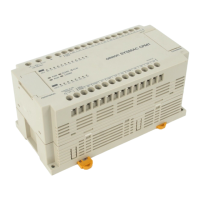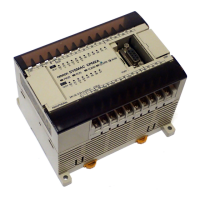74
4-1 Basic Procedure
There are several basic steps involved in writing a program. Sheets that can be
copied to aid in programming are provided in
Appendix E I/O Assignment Sheets
and
Appendix F Program Coding Sheet
.
1, 2, 3...
1. Obtain a list of all I/O devices and the I/O points that have been assigned to
them and prepare a table that shows the I/O bit allocated to each I/O device.
2. If the PC has any Units that are allocated words in data areas other than the
CIO area or are allocated CIO words in which the function of each bit is spe-
cified by the Unit, prepare similar tables to show what words are used for
which Units and what function is served by each bit within the words. These
Units include CPU Bus Units, Special I/O Units, and Link Units.
3. Determine what words are available for work bits and prepare a table in
which you can allocate these as you use them.
4. Also prepare tables of timer and counter numbers and jump numbers so that
you can allocate these as you use them. Remember, timer and counter
numbers can be defined only once within the program; jump numbers can
be used only once each. (timer/counter numbers are described in
5-13 Tim-
er and Counter Instructions
; jump numbers are described in this section.)
5. Draw the ladder diagram. If SFC programming is being used, you will need
to write a ladder diagram for each action program and each transition pro-
gram. You will also need to write interrupt programs if they are required.
Note The CVM1 does not support SFC programming.
6. Input the program into the CPU. Actual input is done from the CVSS and is
possible in either ladder diagram or mnemonic form.
7. Check the program for syntax errors and correct these.
8. Execute the program to check for execution errors and correct these.
9. After the entire Control System has been installed and is ready for use,
execute the program and fine tune it if required.
The basics of ladder-diagram programming and conversion to mnemonic code
are described in
4-3 Basic Ladder Diagrams
. The rest of Section 4 covers more
advanced programming, programming precautions, and program execution. All
instructions are covered in
Section 5 Instruction Set
.
Section 8 Error Processing
provides information required for debugging. Refer to the
CVSS Operation
Manuals
for program input, debugging, and monitoring procedures.
4-2 Instruction Terminology
There are basically two types of instructions used in ladder-diagram program-
ming: instructions that correspond to the conditions on the rungs of the ladder
diagram and are used in instruction form only when converting a program to
mnemonic code, and instructions that are used on the right side of the ladder
diagram and are executed according to the conditions on the instruction lines
leading to them.
Most instructions have at least one or more operands associated with them.
Operands indicate or provide the data on which an instruction is performed.
These are sometimes input as the actual numeric values, but are usually the ad-
dresses of data area words or bits that contain the data to be used. For instance,
a MOVE instruction that has CIO 0000 designated as the source operand will
move the contents of CIO 0000 to some other location. The other location is also
designated as an operand. A bit whose address is designated as an operand is
called an operand bit; a word whose address is designated as an operand is
called an operand word. If the value is entered as a constant, it is preceded by #
to indicate it is not an address, but the actual value to be used in the instruction.
Refer to
Section 5 Instruction Set
for other terms used in describing instructions.
Instruction Terminology Section 4-2

